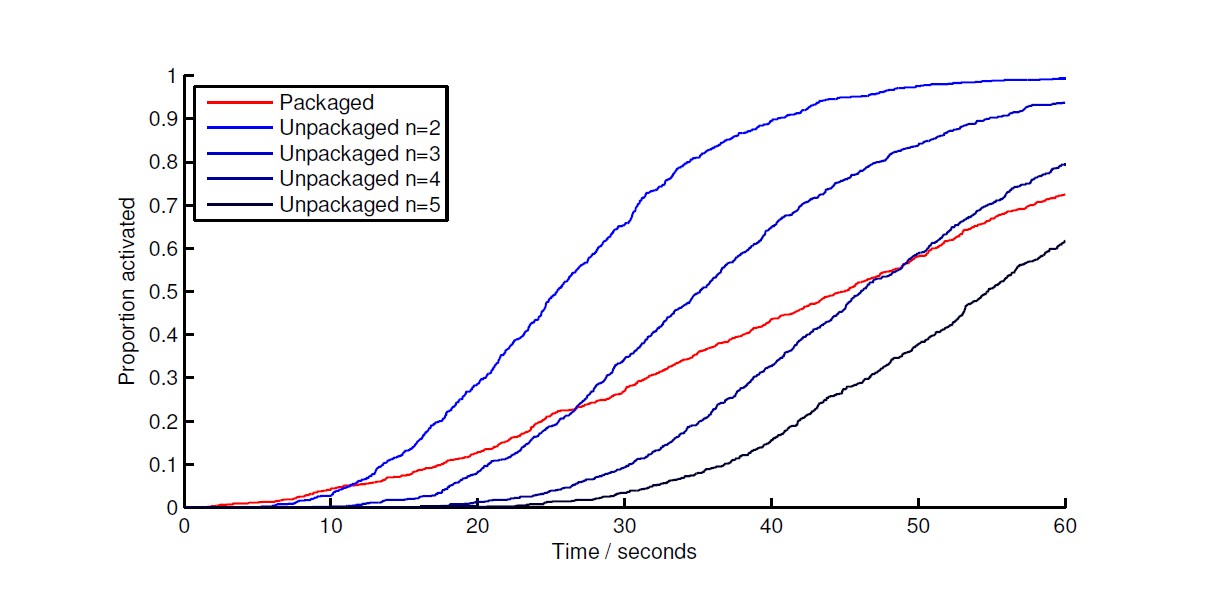Team:BCCS-Bristol/BSim/Case studies/VESECURE
From 2009.igem.org
iGEM 2009
Contents |
Background
The hypothesized engineering advantage that the modelling team chose to focus on was simultaneous delivery of proteins into cells.
We considered n genetic toggle switches [1] linked up in series, such that a reporter protein is transcribed only when all the switches are down. We imagined each toggle switch to be activated by a different protein, represented by the different colours in the diagram below:
Furthermore, we allow the switches to ‘pop open’ after some length of time Δ, if the circuit has not been completed. This means that if all the proteins do not arrive within Δ of one another, the reporter is not activated:
Experiments
We wished to compare the rates of activation in a population of bacteria where proteins are packaged in vesicles (constrained to arrive simultaneously) versus unpackaged dissemination into the environment (where no such constraint arises).
To ensure bacteria can not activate themselves, we consider two populations:

Experiments were carried out using the BSim agent-based modelling framework. We considered 100 E. coli in a volume of fluid of size (100 microns)^3 with wrapping boundary conditions, maintaining a bacterial density of 1e-4 bacteria/micron^3. The temperature was set to 305 K and the viscosity to 2.7e-3 Pa s. BSim features accurate models of E. coli motility and Brownian motion (important for vesicle and protein motion).
For experiments featuring packaged delivery, vesicles were produced at a realistic average rate of v = 0.25 vesicles/sec. We assume that there are n proteins/vesicle (one of each kind), resulting in a packaged protein production rate of nv.
For experiments featuring unpackaged delivery, proteins were produced at the same rate as packaged proteins (nv) for purposes of comparison. Vesicles had a radius of 20nm whilst individual proteins had a radius of a few nm. We assume every bacterium-(protein/vesicle) collision results in activation of the appropriate switch(es).
We recorded the proportion of activated bacteria in the population as a function of time for different values of Δ (the time before switches pop open), n (the number of switches making up a series switch in a bacterium) and the packaging method (packaged or unpackaged). We considered two limits of Δ:
- Δ → 0 (switches pop open straight away): In this case, we expect packaged delivery via vesicles to result in a significantly enhanced rate of activation, as the chances of two unpackaged proteins arriving simultaneously will be low.
- Δ → ∞ (switches stay shut indefinitely): Here, unpackaged proteins need not arrive simultaneously to activate the reporter, though packaged delivery may still be a more efficient method of activation.
Note that the proportion of activated bacteria in the population as a function of time for packaged delivery is independent of both n and Δ as all n proteins arrive simultaneously by definition. Footage of a simulation is shown below (two populations in red and green):
'Switches pop open straight away'
The graph below shows the proportion of activated bacteria in the population as a function of time averaged over 10 runs for Δ → 0. For unpackaged delivery to activate a bacterium in this limit, all n proteins must arrive simultaneously by chance. For the case n=2, we see that this does indeed happen. For n ≥ 3, it never happens (and so the curves are not shown).
As expected, the proportion of activated bacteria where proteins are packaged into vesicles is consistently and significantly higher even for n=2 unpackaged proteins.
'Switches stay shut indefinitely'
The graph below shows the proportion of activated bacteria in the population as a function of time averaged over 10 runs for Δ → ∞. In this limit it is not necessary for all n proteins to arrive simultaneously to active a bacterium. However, the results suggest that if the series switch consists of more than about n=4 toggle switches, it is more effective to deliver the proteins bundled in a vesicle.
References
- [1] Timothy S. Gardner, Charles R. Cantor & James J. Collins - Construction of a genetic toggle switch in Escherichia coli | doi:10.1038/35002131
 "
"




